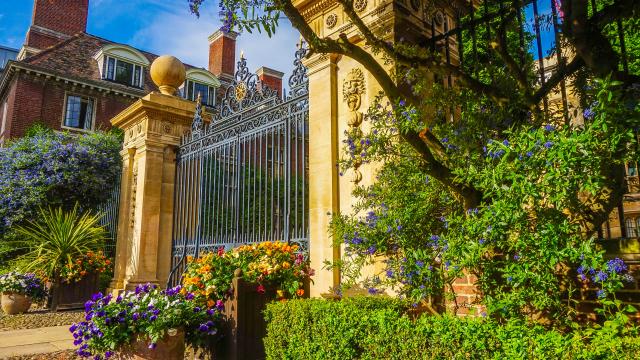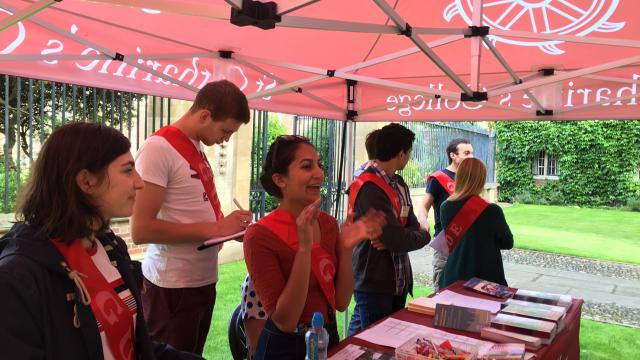
The Wisdom Window was dedicated by The Right Rev'd Dr David Thomson, Bishop of Huntingdon during a ceremony conducted by The Rev'd Dr Anthony Moore, Dean of Chapel, on Sunday 14th October, 2012.
The window was given in memory of Neville Burston, an alumnus of the College, by his son, Richard, and family.
The following address was given by Tom Denny, the artist, as part of the dedication ceremony
'An artist who makes a work for such a place as St Catharine's College is extraordinarily fortunate: within the community here are those who will explore the themes of the work with knowledge and wisdom; it is very satisfying to think of leaving something in a place where new and unexpected ideas can emerge from it over years to come.
Katharine Dell has told us something of the perception of wisdom in the Old Testament as simultaneously earthly and heavenly - a practical guest at one moment, a closeness to God at the next. Stained-glass is a medium that is peculiarly well-adapted for multifarious expression of ideas, where at first one can be strongly aware of colour and light as a kind of musical language, a 'humming' of colour, a riverine movement of light. And then there is room for the development of whole worlds of narrative and detail. The discovery of detail can be an enjoyable aspect of stained-glass visiting, but it also points to the very purpose and meaning of such a work as this- a place for contemplation.
So the window is an explanation of passages from the Book of Proverbs, with wisdom described, suggested and personified in various ways - as one who 'was there when He marked out the foundations of the earth', who cries 'I was filled with delight day after day, rejoicing always in His presence' but who also offers prudence and understanding to those who pass her at the gates of the city.
Wisdom is 'a tree of life to them that lay hold upon her.' So here a tree is embedded in the architectural structure of the window and arches over the stories, places and objects scattered over its surface and in its depths. The centrality of this tree image suggests the place of wisdom at the heart of creation: 'the Lord brought me forth as the first of His works.' But other works followed. In the words of a book of sermons of 1712 to be found in the Bursar's Office: 'Physico-Theology: a demonstration of the Being and Attributes of God from his works of Creation.' We are surrounded here by these attributes - hills, clouds, the stars of the heavens, the face of the deep, seeds, minerals, stones, trees.
And by ways in, by pathways. Proverbs is full of the idea of wisdom being discovered on a journey, of walking on her pathways:
' all her paths are peace'; 'paths of righteousness'; 'I will lead thee in the right paths'; 'Seekest her, searchest for her.'
So we are here offered many paths to explore and many glimpses of fellow-journeyers. The tree of life itself threads its way into its surroundings. In the left-hand light, two set forth, already full of conversation and questing; they will encounter the shadowy figure of a woman - wisdom - who has 'taken her stand along the way where the paths meet.' And where do these paths meet? This is a Cambridge landscape, of willows and wet pastures. Above, one sees a chalk down, reminiscent of the Gog Magog Hills, where the viewer has many choices of paths to climb to the summit.
Landscape is, of course, something to be experienced as much in a pebble or a patch of lichen as in a stretch of scenery. Addenbrooke's cabinet at St Catharine's has drawers of stones, fossils minerals, seeds - these foundations of curiosity and knowledge, pointers to the idea of searching and finding, may be found enmeshed in the colour and imagery of the window, in the surfaces of the paths, in the leaves of the tree. I was glad, incidentally, to find that Dr Addenbrooke had picked up, in walking on the chalk hills of Cambridgeshire, the same fossil sea urchins that I like to discover walking on the chalk hills of Dorset.
There are people walking on a hill in the middle of the right-hand light; they are walking through the moment of creation, perhaps unaware of the presence of God 'making out the horizon on the face of the deep' with wisdom at his side.
Below, a young man pauses on the threshold of a gateway into the world, accosted by the advent of wisdom, one who 'crieth at the gates "Hear, for I speak of excellent things."' A revelatory conversation perhaps, but surrounded by familiarity and ordinariness: the gateway itself derives from one at St Catharine's; a bike leans against the wall, a dog observes (as in one of Veronese's biblical paintings, although he got into trouble for such mingling of sacred and earthly).
I like to value and depict those things that give individuality and texture to a place. The figures at the gateway are standing on cobbles that may seem familiar to members of this College. These figures - all of the figures - are quite ramshackle in their clothing, another Cambridge familiarity where people can sometimes be observed too preoccupied with interesting thoughts to be aware of their shoes.
This window has been introduced into a gathering of windows of different periods. By being the fourth of these windows, it returns the Chapel to symmetry and balance. It is intended that, by making visual connections with the existing windows, the new window will be at home in this gathering. The use of materials and techniques more or less the same as those in use in 1480 or 1880 helps achieve this connection. The new window also contributes to the return to the College of something that was stolen by the iconoclasm of William Dowsing who writes 'December 26, 1643. At Katherine Hall we pulled down ...' and he goes on to describe the various windows destroyed, probably fifteenth century glass. One of Dowsing's most ardent associates - included in that 'we', no doubt - was a man named Thomas Denny.
All of the windows in the Chapel contain inscriptions, coats of arms, emblems. To make these things less immediately apparent is not to be disrespectful. The emblem of the College in the wisdom window, for example, shares its identity with the sun at the top; the inscription is arranged on a series of fragments of slate set amongst the cobbles.
The making of the window occupied me for a year. Stained-glass involves the gathering together of many elements that might too easily be disjointed: pieces of coloured glass; various treatments to that glass, some of which involve the subsequent addition of drawing to colour; leadlines; the particular demands of the setting. And the stained-glass artist relies on a serious contribution from others - it is a collaborative medium. So here, Patrick Costeloe was responsible for the craftsmanship of cutting and leading, and David Whyman for that of installation. And, as well as a great deal of gratitude to them, there is much gratitude due to Richard Burston and his family, and to the College, for allowing me to have the exciting and enjoyable task of making this work for this place - a work that, I hope, will still reward the eyes of the inhabitants of the College who see it for the twentieth time, or the two-hundredth time, as well as those who have come here today.'




